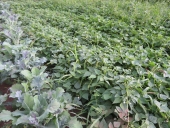
















boddah wrote:
this post has me thinking about a thread i created that no one responded to. about how i could deal with a slow moving seasonal stream. i wonder if throwing a lot of my extra rocks in it would do away with the standing water algae while also preserving the water in the hot months particuarly if i take out a few of the trees shading it.
the only drawback i can think of using rock as mulch is if you ever intend to mow or till anywhere near it. not really a problem for me.

















Leila wrote:
SILVERSEEDS, are you using stones in areas where you're fertilising?




SILVERSEEDS wrote:
in my experiments, in my conditions, with materials I have on had.... my experiments show me a good layer of compost, with a standard type mulch, with rocks over it is the best. this is on top of the soil on many perennial plants that grow in my native soil, and over top my prepared beds as well.
I have found each serves divergent and related purposes. the compost is where I have my life forms, the mulch protects them and all the other things mulch does, and the rocks over that do their thing....
I intend to pull back the rocks and add more mulches every few years, ensuring I have something for those soil beasties to dig into.
On my annual beds i dont always use them at this point, but I will especially as I bred the crops that will ultimately be what Im growing.




toddh wrote:
Using the baseball size rocks make a lot of sense Silverseeds. I was curious how they would put their compost down with the gravel there. It's hard enough to move gravel with a shovel.
thanks




I would feel more optimistic about a bright future for man if he spent less time proving that he can outwit Nature and more time tasting her sweetness and respecting her seniority.
-E.B. White








The ultimate goal of farming is not the growing of crops, but the cultivation and perfection of human beings. - Masanobu Fukuoka




SILVERSEEDS wrote:
Ive got two places. I dont have to many rocks around my place in town. Ive got a place in the mountains though that has then everywhere, that where i get mine....
I realized I didnt explain myself to well before. in the perennial beds I use rock of any size really as long as the top side wouldnt be collecting water rather then letting it pass. Some eggs size or so, some football size or bigger. All of them things I could move every few years if i wanted to remulch the perennial beds. which is wise, its good for the biota. Every year might even be better, but mine seemed to not "need" it for about 3 years. Probably depends a lot on where you are and the quality of materials youve got to.
the baseball sized ones are for areas where I move them alot. I like those to be roughly the same size, and thats a easy size to work with. I can sweep my hand across a decent sized area, ensure I move them all fast and simply, do whatever work I was intending, and scoop them back.
I would feel more optimistic about a bright future for man if he spent less time proving that he can outwit Nature and more time tasting her sweetness and respecting her seniority.
-E.B. White

|
This tiny ad is naturally water proof
A rocket mass heater heats your home with one tenth the wood of a conventional wood stove
http://woodheat.net
|



